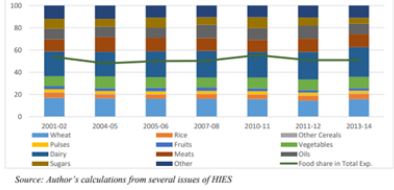Unraveling Nutritional Landscapes: A Holistic Examination of Food Utilization, Sustainability, and Childhood Nutrition in Pakistan
Keywords:
Dietary Problems, Malnutrition, Environmental Issues, Socio-Economic Status, Sedentary BehaviorAbstract
The majority of developing countries have ongoing dietary problems. This comprehensive review delves into the multifaceted landscape of food utilization, sustainability, and nutritional challenges in Pakistan. The research scrutinizes food insecurity trends, dietary patterns, childhood obesity, and malnutrition. Drawing insights from a dataset encompassing 24,809 residences, the analysis focuses on 16,340 homes, evaluating various food categories and household food insecurity. Findings reveal an alarming increase in food insecurity from 58% (2005-2006) to 77.4% (2013-14), with urban households experiencing higher vulnerability. Seasonal variations in food consumption highlight the importance of tailored interventions. Examining sustainability, the study addresses environmental issues, water resource depletion, population growth, and governance disparities affecting future food supply stability. Sustainable Food and Nutrition Security is explored through socially, economically, and environmentally sustainable measures, emphasizing the necessity of shaping public policies for enduring food security. The study underscores the global concern of childhood obesity and persistent stunting in Pakistan, affecting 38% of children under five. Risk factors include socio-economic status, sedentary behavior, and inadequate physical activity. Recommendations emphasize targeted interventions, parental awareness, and informed initiatives to combat childhood nutrition challenges. Analyzing nutritional consumption patterns, the study unveils deficiencies in protein, vitamins A, B, C, and essential minerals. The income elasticity of consumption is explored through Engel curves, revealing shifts in dietary preferences with economic growth. Noteworthy variations in nutrient consumption across provinces and household sizes underscore the need for tailored policy approaches. In conclusion, the study advocates for poverty alleviation initiatives, such as direct cash transfers, as effective strategies for improving nutritional well-being. The findings emphasize the dynamic interplay between socio-economic factors and dietary choices, urging policymakers to consider holistic approaches for sustainable food security in diverse regions of Pakistan.
comprehensive review delves into the multifaceted landscape of food utilization, sustainability, and nutritional challenges in Pakistan. The research scrutinizes food insecurity trends, dietary patterns, childhood obesity, and malnutrition. Drawing insights from a dataset encompassing 24,809 residences, the analysis focuses on 16,340 homes, evaluating various food categories and household food insecurity. Findings reveal an alarming increase in food insecurity from 58% (2005-2006) to 77.4% (2013-14), with urban households experiencing higher vulnerability. Seasonal variations in food consumption highlight the importance of tailored interventions. Examining sustainability, the study addresses environmental issues, water resource depletion, population growth, and governance disparities affecting future food supply stability. Sustainable Food and Nutrition Security is explored through socially, economically, and environmentally sustainable measures, emphasizing the necessity of shaping public policies for enduring food security. The study underscores the global concern of childhood obesity and persistent stunting in Pakistan, affecting 38% of children under five. Risk factors include socio-economic status, sedentary behavior, and inadequate physical activity. Recommendations emphasize targeted interventions, parental awareness, and informed initiatives to combat childhood nutrition challenges. Analyzing nutritional consumption patterns, the study unveils deficiencies in protein, vitamins A, B, C, and essential minerals. The income elasticity of consumption is explored through Engel curves, revealing shifts in dietary preferences with economic growth. Noteworthy variations in nutrient consumption across provinces and household sizes underscore the need for tailored policy approaches. In conclusion, the study advocates for poverty alleviation initiatives, such as direct cash transfers, as effective strategies for improving nutritional well-being. The findings emphasize the dynamic interplay between socio-economic factors and dietary choices, urging policymakers to consider holistic approaches for sustainable food security in diverse regions of Pakistan.


















